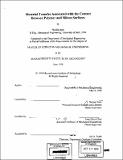| dc.contributor.advisor | Nannaji Saka and Jung-Hoon Chun. | en_US |
| dc.contributor.author | Iyer, Nandini, 1974- | en_US |
| dc.date.accessioned | 2010-02-09T16:45:22Z | |
| dc.date.available | 2010-02-09T16:45:22Z | |
| dc.date.copyright | 1998 | en_US |
| dc.date.issued | 1998 | en_US |
| dc.identifier.uri | http://hdl.handle.net/1721.1/51564 | |
| dc.description | Thesis (S.M.)--Massachusetts Institute of Technology, Dept. of Mechanical Engineering, 1998. | en_US |
| dc.description | Includes bibliographical references (leaves 126-129). | en_US |
| dc.description.abstract | Material transfer due to the contact of surfaces is encountered in a wide variety of engineering applications. One of these is the backside contamination of silicon wafers due to contact with polymer vacuum chucks during spin coating. The present research investigates material transfer associated with this contact. The contact between the silicon wafer and the vacuum chuck was idealized as pin-on-flat interaction and an experimental apparatus was fabricated based on this model. Material transfer from a variety of solid polymers (UHMWPE, Teflon, KEL-F, PMMA, PEEK, and Nylon 66) was studied and characterized by Scanning Electron Microscopy, Atomic Force Microscopy, Optical Microscopy and computer image analysis. This was augmented with studies of material transfer from polymeric films (Polyethylene, Teflon, and Kapton) and ceramics (quartz, sapphire and ruby). The variables of interest for the material transfer phenomenon were identified using analysis of elastic contacts (Hertzian) and adhesion. Experimental results suggest that the material transfer was affected by the contact area that forms between the polymer and the silicon substrate and by the contact pressure at the surface asperities. At low loads, contact area and pressure decreases causing less transfer. There is a linear relationship between the total particle area and the Hertzian contact area. For elastic contacts, the effect of surface roughness is not pronounced. Friction and surface energy also appear to be weak variables in the material transfer phenomenon. The Young's moduli of the polymers also affect material transfer. The number of particles transferred and the total particle area decreased with an increase in Young's modulus. No material transfer was observed with Kapton, quartz, sapphire and ruby. Material transfer was also inhibited with the use of a small amount of lubricant. | en_US |
| dc.description.statementofresponsibility | by Nandini Iyer. | en_US |
| dc.format.extent | 129 leaves | en_US |
| dc.language.iso | eng | en_US |
| dc.publisher | Massachusetts Institute of Technology | en_US |
| dc.rights | M.I.T. theses are protected by
copyright. They may be viewed from this source for any purpose, but
reproduction or distribution in any format is prohibited without written
permission. See provided URL for inquiries about permission. | en_US |
| dc.rights.uri | http://dspace.mit.edu/handle/1721.1/7582 | en_US |
| dc.subject | Mechanical Engineering | en_US |
| dc.title | Material transfer associated with the contact between polymer and silicon surfaces | en_US |
| dc.type | Thesis | en_US |
| dc.description.degree | S.M. | en_US |
| dc.contributor.department | Massachusetts Institute of Technology. Department of Mechanical Engineering | en_US |
| dc.identifier.oclc | 42997027 | en_US |
